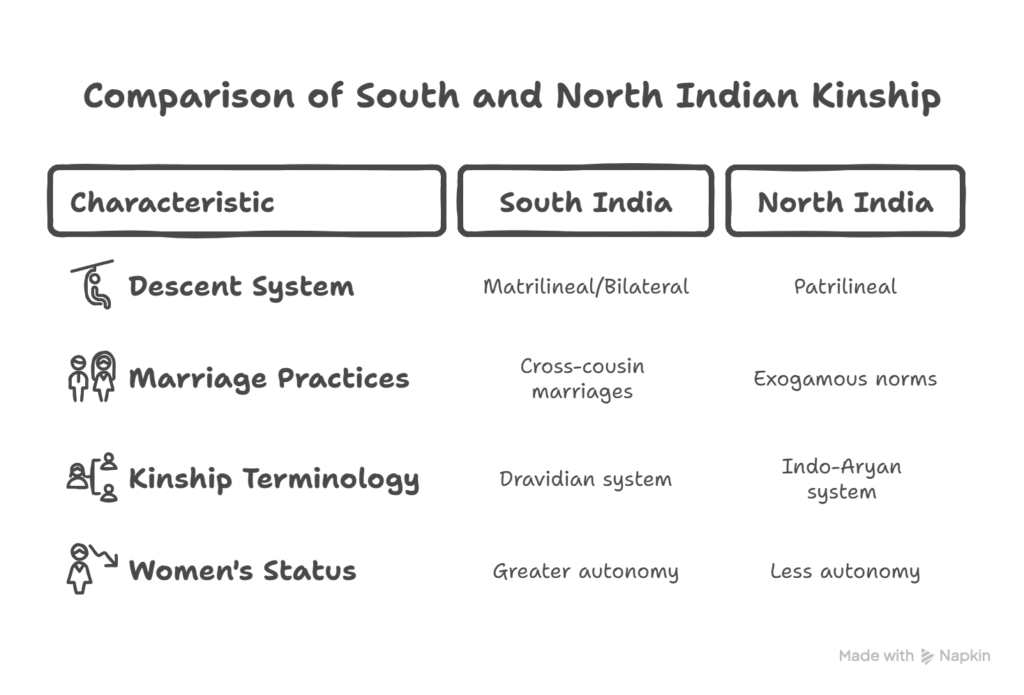Introduction on Kinship Bonds
Kinship, the network of social ties that make up human societies, is essential in determining marriage customs, inheritance patterns, cultural standards, and familial responsibilities. In India, kinship structures vary significantly between the northern and southern regions due to historical, geographical, and socio-cultural influences. While North Indian kinship is predominantly patrilineal and follows strict clan exogamy, South Indian kinship exhibits greater flexibility, often permitting cross-cousin marriages and recognizing bilateral descent in certain communities.
This article explores the sociological dimensions of kinship bonds in North and South India, analyzing differences in marriage systems, family structures, inheritance patterns, and gender roles. By examining these variations, we can better understand how kinship influences social organization, economic behavior, and cultural practices in these two regions.

Table of Contents
1. Kinship Systems in North India
1.1 Patrilineal and Patriarchal Structure
The male line is used to trace descent and inheritance in North Indian kinship, which is mostly patrilineal. The family structure is patriarchal, with authority vested in the eldest male member. Property, surnames, and familial responsibilities are passed down from father to son, reinforcing male dominance in both familial and social spheres.
1.2 Clan Exogamy and Gotra System
A defining feature of North Indian kinship is the practice of clan exogamy, where marriage within one’s gotra (patrilineal clan) is strictly prohibited. The gotra system, rooted in Brahmanical traditions, mandates that individuals marry outside their lineage to maintain social and genetic diversity. This practice extends beyond immediate family, often prohibiting marriages between individuals belonging to the same village or even distant kin groups.
1.3 Hypergamy and Dowry Practices
Hypergamy—where women marry men of higher social status—is another notable aspect of North Indian kinship. This practice reinforces caste hierarchies, as families seek alliances with higher-status groups. The dowry system, where the bride’s family provides gifts and wealth to the groom’s family, is deeply entrenched in North Indian marriage customs, often leading to economic burdens and gender disparities.
1.4 Joint Family System
Traditionally, North Indian families followed the joint family system, where multiple generations lived under one roof, sharing resources and responsibilities. However, urbanization and economic changes have led to a gradual shift toward nuclear families, though kinship obligations remain strong.

2. Kinship Systems in South India
2.1 Bilateral and Matrilineal Influences
Unlike North India, South Indian kinship exhibits greater diversity, with some communities following matrilineal or bilateral descent systems. For instance, the Nairs of Kerala and the Bunts of Karnataka traditionally practiced matrilineal inheritance, where property and family names were passed through the female line. Even in patrilineal communities, kinship ties are more flexible, with both maternal and paternal relatives playing significant roles.
2.2 Cross-Cousin and Uncle-Niece Marriages
A striking feature of South Indian kinship is the prevalence of consanguineous marriages, particularly cross-cousin marriages (marrying one’s maternal uncle’s daughter or paternal aunt’s son). In some communities, such as the Reddy and Vellalar castes, uncle-niece marriages were historically permitted. These practices strengthen familial alliances and property consolidation, contrasting sharply with North India’s exogamous norms.
2.3 Dravidian Kinship Terminology
South Indian kinship follows the Dravidian terminology system, which classifies relatives differently from the Indo-Aryan system of the North. For example, the same term may be used for maternal uncle and father-in-law, reflecting the cultural acceptance of cross-cousin marriages. This system emphasizes the equivalence of certain kin roles, reinforcing close-knit familial bonds.
2.4 Women’s Status and Inheritance Rights
While patriarchy exists in South India, women historically enjoyed greater autonomy, especially in matrilineal communities. The Marumakkathayam system in Kerala allowed women to inherit property and manage household affairs. Even in patrilineal communities, women often had more agency in marital choices compared to their North Indian counterparts.

3. Comparative Analysis of North and South Indian Kinship bond
3.1 Marriage Systems and Social Structure
- North India: Marriage is viewed as a union between two families rather than individuals, with strict rules on gotra and village exogamy.
- South India: Marriage is often seen as a means to reinforce existing kin ties, with cross-cousin marriages ensuring wealth remains within the family.
3.2 Inheritance and Property Rights
- North India: Strict patrilineal inheritance excludes women from ancestral property, though legal reforms (like the Hindu Succession Act, 2005) have sought to change this.
- South India: Greater acceptance of women’s property rights, especially in matrilineal communities, though modernization has led to shifts toward patrilineal norms.
3.3 Gender Roles and Familial Authority
- North India: Strong patriarchal control, with limited autonomy for women in marital decisions.
- South India: Relatively more egalitarian, with women playing active roles in kinship networks and economic activities.
3.4 Impact of Modernization and Urbanization
Both regions have seen changes due to globalization, education, and economic shifts:
- Decline in joint families and rigid caste-based marriage rules.
- Increased love marriages and intercaste unions, though regional differences persist.
- Legal reforms improving women’s inheritance rights across India.
4. Conclusion on Kinship Bonds
The kinship bonds in North and South India reflect deep-rooted cultural, historical, and social influences. While North Indian kinship is characterized by patrilineality, clan exogamy, and rigid gender hierarchies, South Indian kinship displays greater flexibility with practices like cross-cousin marriages and matrilineal inheritance. These differences shape familial relationships, economic behaviors, and social structures in distinct ways.
Understanding these kinship variations is essential for sociologists, policymakers, and social workers addressing issues like gender inequality, property disputes, and marital practices in India. As modernization continues to transform familial structures, the interplay between traditional kinship norms and contemporary values will remain a critical area of study in Indian sociology.
Do you like this this Article ? You Can follow as on :-
Facebook – https://www.facebook.com/hubsociology
Whatsapp Channel – https://whatsapp.com/channel/0029Vb6D8vGKWEKpJpu5QP0O
Gmail – hubsociology@gmail.com
Topic Related Questions on Kinship Bonds
5-Mark Questions on Kinship Bonds (Short Answer Type)
- Define kinship and explain its significance in Indian society.
- What is the gotra system in North Indian kinship?
- Differentiate between patrilineal and matrilineal kinship systems.
- Why is cross-cousin marriage common in South India but prohibited in North India?
- How does the Dravidian kinship terminology system differ from the Indo-Aryan system?
- What is hypergamy, and how does it influence marriage practices in North India?
- Briefly explain the impact of the Hindu Succession Act (2005) on women’s inheritance rights in India.
- What were the key features of the Marumakkathayam system in Kerala?
- How has urbanization affected joint family structures in India?
- Name two matrilineal communities in South India and describe their kinship practices.
10-Mark Questions on Kinship Bonds (Detailed Answer Type)
- Compare and contrast the kinship systems of North and South India with respect to marriage rules and descent patterns.
- Discuss the role of the gotra system in maintaining social order in North Indian kinship structures.
- How do cross-cousin marriages in South India reinforce economic and social stability within families?
- Analyze the changing trends in kinship bonds due to modernization and legal reforms in India.
- Explain the concept of clan exogamy in North India and its implications for caste and gender relations.
- Discuss the impact of dowry and hypergamy on women’s status in North Indian kinship systems.
- How did matrilineal kinship systems in South India challenge traditional patriarchal norms?
- Evaluate the influence of Sanskritization on kinship practices in South India.
- What are the key differences between the joint family system in North and South India?
- How does kinship terminology in South India reflect its unique marriage practices?
15-Mark Questions on Kinship Bonds (Essay-Type/Long Answer)
- “Kinship in North India is rigid and patriarchal, while South India exhibits greater flexibility.” Critically analyze this statement with sociological perspectives.
- Examine the role of kinship in shaping marriage alliances, property rights, and gender roles in North and South India.
- Discuss how historical, geographical, and cultural factors have contributed to differences in kinship structures between North and South India.
- “The gotra system and cross-cousin marriages are two contrasting kinship practices that define North and South India.” Elaborate with examples.
- How have modernization and legal reforms influenced traditional kinship bonds in India? Discuss with reference to both regions.
- Compare the impact of patrilineal and matrilineal kinship systems on women’s empowerment in India.
- Analyze the interplay between caste, kinship, and marriage practices in North and South India.
- “Kinship is not just a familial bond but a socio-economic institution in India.” Justify the statement with regional variations.
- How do inheritance patterns differ between North and South India, and what are their implications for family dynamics?
- Critically assess the changes in Indian kinship structures in the context of globalization and urbanization.
